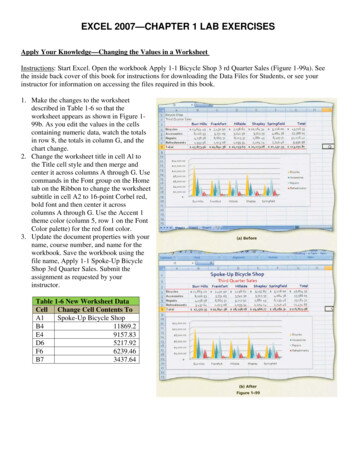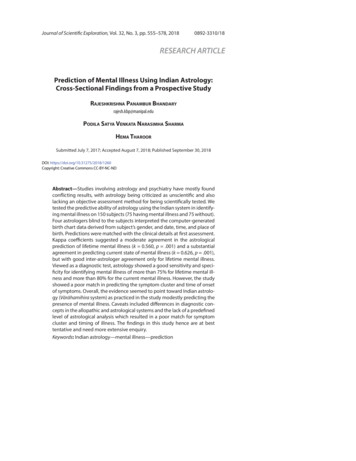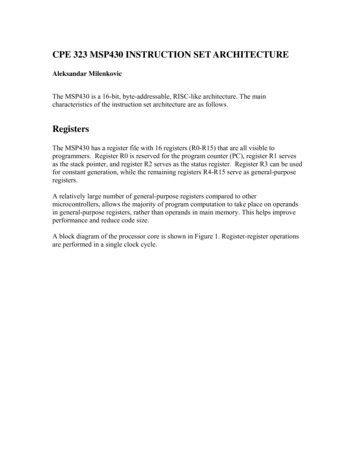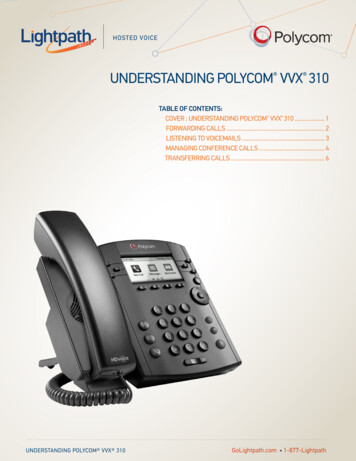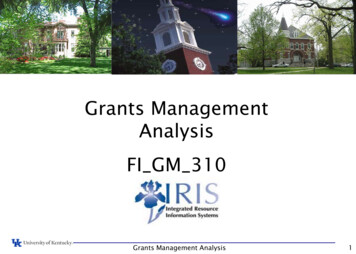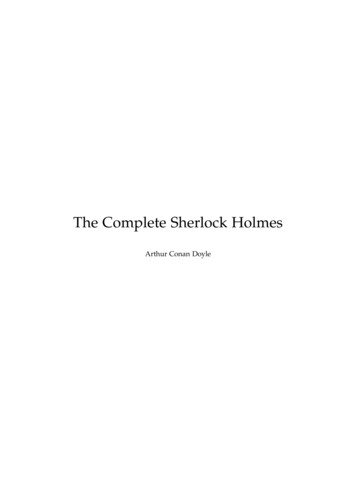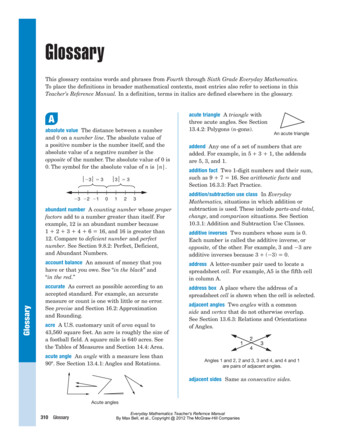
Transcription
GlossaryThis glossary contains words and phrases from Fourth through Sixth Grade Everyday Mathematics.To place the definitions in broader mathematical contexts, most entries also refer to sections in thisTeacher’s Reference Manual. In a definition, terms in italics are defined elsewhere in the glossary.Aabsolute value The distance between a numberand 0 on a number line. The absolute value ofa positive number is the number itself, and theabsolute value of a negative number is theopposite of the number. The absolute value of 0 is0. The symbol for the absolute value of n is n . 3 3 3 3Glossary 3 2 10123acute triangle A triangle withthree acute angles. See Section13.4.2: Polygons (n-gons).An acute triangleaddend Any one of a set of numbers that areadded. For example, in 5 3 1, the addendsare 5, 3, and 1.addition fact Two 1-digit numbers and their sum,such as 9 7 16. See arithmetic facts andSection 16.3.3: Fact Practice.addition/subtraction use class In EverydayMathematics, situations in which addition orsubtraction is used. These include parts-and-total,change, and comparison situations. See Section10.3.1: Addition and Subtraction Use Classes.abundant number A counting number whose properfactors add to a number greater than itself. Forexample, 12 is an abundant number because1 2 3 4 6 16, and 16 is greater than12. Compare to deficient number and perfectnumber. See Section 9.8.2: Perfect, Deficient,and Abundant Numbers.additive inverses Two numbers whose sum is 0.Each number is called the additive inverse, oropposite, of the other. For example, 3 and -3 areadditive inverses because 3 (-3) 0.account balance An amount of money that youhave or that you owe. See “in the black” and“in the red.”address A letter-number pair used to locate aspreadsheet cell. For example, A5 is the fifth cellin column A.accurate As correct as possible according to anaccepted standard. For example, an accuratemeasure or count is one with little or no error.See precise and Section 16.2: Approximationand Rounding.address box A place where the address of aspreadsheet cell is shown when the cell is selected.acre A U.S. customary unit of area equal to43,560 square feet. An acre is roughly the size ofa football field. A square mile is 640 acres. Seethe Tables of Measures and Section 14.4: Area.acute angle An angle with a measure less than90 . See Section 13.4.1: Angles and Rotations.adjacent angles Two angles with a commonside and vertex that do not otherwise overlap.See Section 13.6.3: Relations and Orientationsof Angles.1243Angles 1 and 2, 2 and 3, 3 and 4, and 4 and 1are pairs of adjacent angles.adjacent sides Same as consecutive sides.Acute angles310 Glossary310 323 GL TRM 045951.indd 310Everyday Mathematics Teacher's Refernce ManualBy Max Bell, et al., Copyright @ 2012 The McGraw-Hill Companies3/15/11 8:46 AM
algebra (1) The use of letters of the alphabet torepresent numbers in equations, formulas, andrules. (2) A set of rules and properties for anumber system. (3) A school subject, usuallyfirst studied in eighth or ninth grade. SeeSection 17.2: Algebra and Uses of Variables.l4 x 10w4 ? 104 10Area length widthA l w4 10a b b aa(b c) ab acFormulas, equations, and properties using algebraalgebraic expression An expression that contains avariable. For example, if Maria is 2 inches tallerthan Joe and if the variable M representsMaria’s height, then the algebraic expressionM - 2 represents Joe’s height. See algebra andSection 17.2: Algebra and Uses of Variables.analog clock (1) A clock thatshows the time by the positionsof the hour and minute hands.(2) Any device that showstime passing in a continuousmanner, such as a sundial.Compare to digital clock. SeeSection 15.2.1: Clocks.An analog clock-angle A suffix meaning angle, or corner.angle A figure formed by two rays or two linesegments with a common endpoint called thevertex of the angle. The rays or segments arecalled the sides of the angle. An angle ismeasured in degrees between 0 and 360. Oneside of an angle is the rotation image of the otherside through a number of degrees. Angles arenamed after their vertex point alone as in Abelow; or by three points, one on each side andthe vertex in the middle as in BCD below.See acute angle, obtuse angle, reflex angle,right angle, straight angle, and Section 13.4.1:Angles and Rotations.algebraic order of operations Same as orderof operations.altitude (1) In Everyday Mathematics, same asheight of a figure. (2) Distance above sea level.Same as elevation.Altitudes of 2-D figures are shown in blue.Anglesanthropometry The study of human body sizesand proportions.apex In a pyramid or cone, the vertex opposite thebase. In a pyramid, all the nonbase faces meetat the apex. See Section 13.5.2: Polyhedrons andSection 13.5.3: Solids with Curved Surfaces.apexGlossaryalgorithm A set of step-by-step instructionsfor doing something, such as carrying out acomputation or solving a problem. The mostcommon algorithms are those for basic arithmeticcomputation, but there are many others. Somemathematicians and many computer scientistsspend a great deal of time trying to find moreefficient algorithms for solving problems. SeeChapter 11: Algorithms.approximately equal to ( ) A symbol indicatingan estimate or approximation to an exact value.For example, π 3.14. See Section 16.2:Approximation and Rounding.Altitudes of 3-D figures are shown in blue.Everyday Mathematics Teacher's Refernce ManualBy Max Bell, et al., Copyright @ 2012 The McGraw-Hill Companies310 323 GL TRM 045951.indd 311Glossary3113/15/11 8:46 AM
arc of a circle A part of a circle between andincluding two endpoints on the circle. Forexample, the endpoints of the diameter of a circledefine an arc called a semicircle. An arc is namedby its endpoints.arithmetic facts The addition facts (whole-numberaddends 9 or less); their inverse subtraction facts;multiplication facts (whole-number factors 9 orless); and their inverse division facts, exceptthere is no division by zero. There are:100 addition facts: 0 0 0 through 9 9 18;100 subtraction facts: 0 - 0 0 through 18 - 9 9;100 multiplication facts: 0 0 0 through 9 9 81;90 division facts:Arcsarea The amount of surface inside a 2-dimensionalfigure. The figure might be a triangle or rectanglein a plane, the curved surface of a cylinder, or astate or country on Earth’s surface. Commonly,area is measured in square units such as squaremiles, square inches, or square centimeters. SeeSection 14.4: Area.2 cmSee extended facts, fact extensions, fact power, andSection 16.3.2: Basic Facts and Fact Power.arm span Same as fathom.array (1) An arrangement of objects in aregular pattern, usually rows and columns.(2) A rectangular array. In Everyday Mathematics,an array is a rectangular array unless specifiedotherwise. See Section 10.3.2: Multiplication andDivision Use Classes and Section 14.4: Area.Associative Property of Addition A property ofaddition that three numbers can be added in anyorder without changing the sum. For example,(4 3) 7 4 (3 7) because7 7 4 10.1.2 cmA rectangle with area1.2 cm 2 cm 2.4 cm20/1 0 through 81/9 9.A triangle with area21 square unitsIn symbols:For any numbers a, b, and c,(a b) c a (b c).Subtraction is not associative. For example,(4 - 3) 7 4 - (3 7) because 8 -6.GlossaryThe area of the United Statesis about 3,800,000 square miles.area model (1) A model for multiplication inwhich the length and width of a rectanglerepresent the factors, and the area of the rectanglerepresents the product. See Section 10.3.2:Multiplication and Division Use Classes. (2) Amodel showing fractions as parts of a whole. Thewhole is a region, such as a circle or a rectangle,representing the ONE, or unit whole. See Section9.3.2: Uses of Fractions.Area model for 3 5 15312 Glossary310 323 GL TRM 045951.indd 312Area model for23Associative Property of Multiplication A propertyof multiplication that three numbers can bemultiplied in any order without changing theproduct. For example, (4 3) 7 4 (3 7)because 12 7 4 21.In symbols:For any numbers a, b, and c,(a b) c a (b c).Division is not associative. For example,(8 /2)/4 8/(2 /4) because 1 16.astronomical unit The average distance fromEarth to the sun. Astronomical units measuredistances in space. One astronomical unit isabout 93 million miles or 150 million kilometers.attribute A feature of an object or commonfeature of a set of objects. Examples of attributesinclude size, shape, color, and number of sides.Same as property.Everyday Mathematics Teacher's Refernce ManualBy Max Bell, et al., Copyright @ 2012 The McGraw-Hill Companies3/15/11 8:46 AM
axis of a coordinate gridEither of the twonumber lines usedto form a coordinategrid. Plural is axes.See Section 15.3:Coordinate Systems.Wasted Foods403020Red MeatFruitFast Food0Vegetables10Bakery Goodsaverage A typical value for a set of numbers. Ineveryday life, average usually refers to the meanof the set, found by adding all the numbers anddividing by the number of numbers. In statistics,several different averages, or landmarks, aredefined, including mean, median, and mode. SeeSection 12.2.4: Data Analysis.bar graph A graph with horizontal or vertical barsthat represent data. See Section 12.2.3:Organizing and Displaying Data.Percent Wastedautumnal equinox The first day of autumn, whenthe sun crosses the plane of Earth’s equatorand day and night are about 12 hours each.“Equinox” is from the Latin aequi- meaning“equal” and nox meaning “night.” Compare tovernal equinox.Source: The Garbage ProductFat Content of FoodsaxesHot DogsPopcornFrench FriesChocolate FudgePizzaPancakesWhole Milkaxis of rotation A line about which a solidfigure rotates.North Pole0102030Percent of FatSource: The New York Public Library Desk Referencebase (in exponential notation) A number that israised to a power. For example, the base in 53 is5. See exponential notation and Section 10.1.2:Powers and Exponents.bank draft A written order for the exchange ofmoney. For example, 1,000 bills are no longerprinted so 1,000 bank drafts are issued. Peoplecan exchange 1,000 bank drafts for smaller bills,perhaps ten 100 bills.base of a parallelogram (1) The side of aparallelogram to which an altitude is drawn.(2) The length of this side. The area of aparallelogram is the base times the altitude orheight perpendicular to it. See height of aparallelogram and Section 13.4.2: Polygons(n-gons).heightGlossaryballpark estimate A rough estimate; “in theballpark.” A ballpark estimate can serve as acheck of the reasonableness of an answer obtainedthrough some other procedure, or it can be madewhen an exact value is unnecessary or impossibleto obtain. See Section 16.1: Estimation.seBbaaxisbase of a number system The foundation numberfor a numeration system. For example, our usualway of writing numbers uses a base-ten placevalue system. In programming computers orother digital devices, bases of 2, 8, 16, or otherpowers of 2 are more common than base 10.heightSouth PolebaseEveryday Mathematics Teacher's Refernce ManualBy Max Bell, et al., Copyright @ 2012 The McGraw-Hill Companies310 323 GL TRM 045951.indd 313Glossary3133/15/11 8:46 AM
base of a prism or cylinder Either of the two paralleland congruent faces that define the shape of aprism or cylinder. In a cylinder, the base is acircle. See height of a prism or cylinder, Section13.5.2: Polyhedrons, and Section 13.5.3: Solidswith Curved Surfaces.basebasebasebasebasebasebase of a pyramid or cone The face of a pyramid orcone that is opposite its apex. The base of a cone isa circle. See height of a pyramid or cone, Section13.5.2: Polyhedrons, and Section 13.5.3: Solidswith Curved Surfaces.apexapexsebaebasighehtghtheiheightbase of a triangle (1) Any side of a triangle towhich an altitude is drawn. (2) The length of thisside. The area of a triangle is half the base timesthe altitude or height. See height of a triangle andSection 13.4.2: Polygons (n-gons).GlossaryBase-10-Block ShorthandNameBlockShorthandlongbasebase of a rectangle (1) One of the sides of arectangle. (2) The length of this side. The areaof a rectangle is the base times the altitude orheight. See height of a rectangle and Section13.4.2: Polygons (n-gons).basebase ten Our system for writing numbers thatuses only the 10 symbols 0, 1, 2, 3, 4, 5, 6, 7, 8,and 9, called digits. You can write any numberusing one or more of these 10 digits, and eachdigit has a value that depends on its place in thenumber (its place value). In the base-ten system,each place has a value 10 times that of the placeto its right, and 1 tenth the value of the placeto its left.310 323 GL TRM 045951.indd 314base-10 shorthand In Everyday Mathematics, awritten notation for base-10 blocks. See Section9.9.1: Base-10 Blocks.cubebase314 Glossarybase-10 blocks A set of blocks to represent ones,tens, hundreds, and thousands in the base-tenplace-value system. In Everyday Mathematics,the unit block, or cube, has 1-cm edges; the tenblock, or long, is 10 unit blocks in length; thehundred block, or flat, is 10 longs in width; andthe thousand block, or big cube, is 10 flats high.See long, flat, and big cube for photos of theblocks. See base-10 shorthand and Section 9.9.1:Base-10 Blocks.flatbig cubebaseline A set of data used for comparison withsubsequent data. Baseline data can be used tojudge whether an experimental interventionis successful.benchmark A count or measure that can be usedto evaluate the reasonableness of other counts,measures, or estimates. A benchmark for landarea is that a football field is about one acre.A benchmark for length is that the width of anadult’s thumb is about one inch. See Section14.1: Personal Measures.biased sample A sample that does not fairlyrepresent the total population from which it wasselected. A sample is biased if every member ofthe population does not have the same chance ofbeing selected f
Teacher’s Reference Manual. In a definition, terms in italics are defined elsewhere in the glossary. acute triangle A triangle with three acute angles. See Section 13.4.2: Polygons (n-gons). Glossary absolute value The distance between a number and 0 on a number line. The absolute value of a positive number is the number itself, and the
